A groggy Gene Smith quietly saunters down the steps to his basement, flips on the TV and climbs aboard his treadmill.
It’s 5 a.m., and the thump, thump, thump of his feet on the treadmill nearly drown out the volume on the huge, 60-inch projection-screen TV. He watches intently as two basketball teams unwittingly vie to gain his favor.
By day, Smith is the athletic director at Ohio State. By night, early morning and whenever else he can find a free minute, he also serves as the chairman of the NCAA men’s basketball committee, a group of 10 college administrators who will determine which teams are in the tournament and which ones don’t make the cut on Selection Sunday.
The responsibility for choosing the best 68 teams out of 334 eligible Division I schools is one each committee member takes to heart. They talk about the tournament with such reverence that you’d think they teach classes in bracketology. But that’s the degree to which college basketball dominates their lives from mid-November through March.
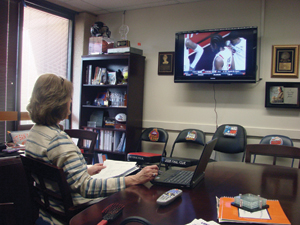 |
UNIVERSITY OF TEXAS-SAN ANTONIO
Committee member Lynn Hickey, athletic director at Texas-San Antonio, studies a game on her office TV. |
The real Madness plays out in the basements, bonus rooms and dens inside the homes of the committee members, each of whom devotes 30 to 40 hours a week watching games so that their preparation for Selection Sunday is beyond reproach. And that’s on top of their jobs as athletic directors and conference commissioners, which regularly require 60-hour work weeks to begin with.
“For me as an AD, I’ve got 36 sports and I try to have a presence at many of them,” Smith said. “I end up missing a lot of those events because I’ve got to be back home watching games. There’s a lot of studying to be done. Some Saturdays, I’ll watch bits and pieces of anywhere from 12 to 20 games.”
On this early morning, Smith, a former football player at Notre Dame, watches portions of three basketball games while he sweats off a few pounds. New players emerge, others get hurt. Teams go on winning streaks and losing streaks. It’s vital to stay in touch with them all.
“It’s a lot to keep up with, but we all understand how important this is to all of the schools involved,” Smith said. “We’ve got to get it right.”
Disruptive due diligence
Basketball junkie doesn’t begin to aptly describe the ADs and commissioners who accept five-year terms on the selection committee. We’re not talking about catching a few games on Saturday and the nightly doubleheaders from Big Monday through the week.
Not only do the 10 committee members see those games, they also have access to every game through ESPN’s Full Court package, every cable station that carries games and any school or conference website that streams games. Schools and conferences also burn games on DVDs and send them to the committee members. Most committee members record games via DVR or TiVo, which allows them to fast forward through everything but the game action, and watch them when they have free time at home or the office.
For the most part, the committee members said they knew what they were getting into. Before they’re selected for the committee, they must first be nominated to the NCAA, either by themselves or by another administrator. Anywhere from eight to 12 people are nominated each year and the NCAA picks two. At the end of this academic year, for example, Smith and California-Riverside AD Stan Morrison will cycle off and two more, West Coast Conference Commissioner Jamie Zaninovich and LSU AD Joe Alleva, come aboard.
When the members join the selection team, the NCAA pays to have DirecTV installed in their home. The NCAA also pays for the ESPN premium package and the full sports tier with all of the regional networks. If there’s a game on, the committee members have access to it. Conferences also provide passwords and waive fees so that members can view their games online. They want as many of their schools to make the tournament as possible, so they make it easy for the committee to see their teams.
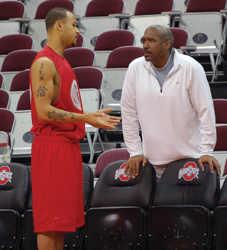 |
OHIO STATE UNIVERSITY
Smith fits in his duties while overseeing Ohio State’s huge athletic program. |
Smith estimates that the satellite installation and premium packages are worth about $700 in the first year, but that’s the extent of their benefits for serving on the committee. Other than the TV packages and reimbursement for any committee-related travel, there’s no compensation for the volunteer positions.
“We provide a secure website just for the members of the committee with as much information as possible,” said David Worlock, the NCAA’s associate director for the tournament. He’s one of 15 NCAA staffers who have some responsibility for the tournament.
“Our broadcast staff collects TV schedules and also any games on the Internet, which are more popular with the conferences that don’t have as many games on regular TV. The committee has to follow 334 Division I teams that are eligible for the tournament, so we try to provide them with as much information as possible.”
In addition to the TV listings, the NCAA provides enough statistical analysis to forecast the next lunar eclipse. Turnover margin, rebounding, points per possession, offensive and defensive efficiency, performance home vs. road — it’s all available on the NCAA’s site.
That minutiae is provided to the committee for their consideration, but they’re not required to study it all. Members create their own methods for evaluating teams, and it’s not a one-size-fits-all approach. Some focus more on the stats, while others prefer to go to games in person, if they have time. Smith, as the chairman, is responsible for keeping tabs on each of the committee members to make sure they’re keeping up.
The committee also has regularly scheduled meetings, both in person and via conference call, where they share their opinions on the different teams. Each committee member is the primary contact for three to four conferences and a secondary contact on three to four more leagues. When they meet early in the season and again in February, the primary contact delivers a report on the teams in those leagues. They meet face-to-face five times during the course of the year.
Sometimes, they want more, so they go to the games in person. They want to see how the players and coaches interact, how the team responds to adversity, how they react to a hostile crowd and whether the perceived leaders on the team step up or shrink in the big moments.
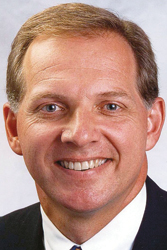 |
| Bobinski |
“We all have our own styles and we emphasize different things,” said Mike Bobinski, AD at Xavier University in Cincinnati and a committee member. “I really like to watch how teams react, how they compose themselves, how organized they are. I’ll watch six to seven games a night, not all of the way through, but chunks of a game. It’s really a blend of won-loss records, RPI. … I skew more toward the qualitative side, others go the other way. The beauty is that we have that balance.”
Some travel more than others, depending on their geographic location. Smith said he has attended 12 to 14 games a year in the past, not including his Buckeyes. From Columbus, it’s a reasonable 3 1/2-hour drive to Lexington, Ky., or Louisville. But this year, he hasn’t traveled as much because of scheduling conflicts. He’s seen just three games not involving Ohio State in person.
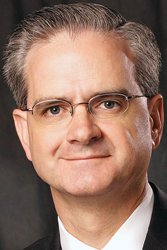 |
| Hathaway |
Jeff Hathaway, AD at Connecticut and a fourth-year committee member who will take Smith’s chair next year, is about a two-hour drive from Madison Square Garden, so many of the games he sees in person are in November and December when MSG overflows with college teams playing early-season tournaments and doubleheaders.
Lynn Hickey, a self-described basketball junkie, was a women’s basketball coach at Texas A&M and Kansas State before she became AD at Texas-San Antonio. When she joined the committee in 2007, Hickey became just the second woman ever on the men’s basketball committee. At the same time, all she’s trying to do is raise $100 million for a new stadium at UTSA and start a football program from scratch, which keeps her pretty busy.
But with her basketball background, she prefers to see as many games in person as possible. She’s about 80 miles from Austin and 170 miles to College Station, where she can catch Texas and Texas A&M against several of the opponents that she needs to study. So when she has a little time in the evening, Hickey hops in her car and drives to a game.
“I wish people could understand how importantly and how seriously the members of the committee take this job,” Hickey said. “We work really hard and it’s out of a concern that we be as absolutely fair as we can be. It’s something that is pretty disruptive to your life, but everyone on the committee does their due diligence.”
Paradise in the cave
During a committee meeting last month, Hickey slipped away from the other members during a break and phoned her husband, who is a former baseball coach. She left him instructions on which games needed to be recorded on DVR that night while she was out of town.
The committee is full of administrators from a variety of backgrounds, but no one challenges Hickey for basketball junkie supremacy. She swears that watching the game never gets old and her fellow committee members believe her. Her team reports at committee meetings are legendary for the amount of detail she includes, both statistically and from observations. When she joined the committee four years ago, Hickey had a TV installed in her office at Texas-San Antonio so that she could record games at home and at school.
“There are so many good games on at the same time,” she said enthusiastically.
Hickey’s main TV at home is in the great room, which is visible from the kitchen, so she can watch games while she cooks. But when there’s competition for the TV, she’s also been known to slip off to her daughter’s room with a notepad to catch a game or two.
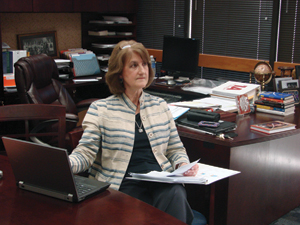 |
UNIVERSITY OF TEXAS-SAN ANTONIO
Texas-San Antonio’s Hickey is legendary for the detail in her team reports. |
On a recent Saturday, Hickey watched a few games at home that morning on DVR and then went to the office where she had recorded a few more. She then attended a funeral, spoke at a school function and watched her daughter, Lauren, a senior at Trinity University and a basketball player, play in her final home game, which caused her to miss UTSA’s women’s game that night. She returned home by 8:30 and proceeded to watch more games. On Sunday, she was in front of the TV all day “trying to catch up,” she said. “That’s my weekend.”
What spells disaster when you’re a basketball committee member?
“When you have games that you recorded and they disappear,” Hickey said. “I’ve had that happen. I still don’t know where they went. But the conferences are very good about burning a game on a DVD and shipping it to you.”
Bobinski, the AD at Xavier, refers to his basement as the cave.
“It’s a completely separate area where nobody bothers me and I don’t bother anybody,” he said.
At night and on weekends, Bobinski retires to his dark brown leather recliner in the basement and flips on his 50-inch TV and puts the legal pad in his lap. His only regret is that he doesn’t have a refrigerator down there.
Bobinski is a prodigious note-taker and he likes to compare his team notes from November to February to see how a team has progressed or regressed.
2010-11
NCAA MEN'S
BASKETBALL
COMMITTEE
|
DAN BEEBE
Commissioner,
Big 12 Conference |
JEFF HATHAWAY
Athletic director,
Connecticut |
STEVE ORSINI
Athletic director,
SMU |
GENE SMITH*
Athletic director,
Ohio State
*Chairman |
MIKE BOBINSKI
Athletic director,
Xavier |
LYNN HICKEY
Athletic director,
Texas-San Antonio |
RON WELLMAN
Athletic director,
Wake Forest |
SCOTT BARNES
Athletic director,
Utah State |
DOUG FULLERTON
Commissioner,
Big Sky Conference |
STAN MORRISON
Athletic director,
California-Riverside |
|
Like Hickey, he fancies himself as a basketball guy. Xavier doesn’t play football.
“There was one Saturday with wall-to-wall basketball,” he said. “A lot of potential at-large teams. Just all-day basketball. A smorgasbord of games. Man, it was a great day.”
When Ohio State’s Smith isn’t in the basement watching the projection TV, he’s in the den in front of a 50-inch flat-panel TV with a smaller 26-inch TV to the side. Want to see a basketball committee member get excited? Put on two games at once.
In front of the dual TVs are his-and-her recliners separated by a small coffee table. Smith’s wife, Sheila, is a former basketball player for the 1976 Canadian Olympic team who also coached at Oregon and UNLV.
“Sometimes she’ll sit and watch with me. Sometimes she disappears,” Smith said with a laugh.
Getting to Selection Sunday
Nearly 40 years ago, when former NCAA executive Tom Jernstedt began running the tournament, the selection committee got together just once, on a conference call that lasted anywhere from four to six hours. That’s how long it took to put together the 25-team bracket, which expanded to 32 in 1975 and eventually to 64 teams in 1985.
“It was a six-person committee and they looked at won-loss records, who they played, and the scores,” Jernstedt said. “That’s it.”
Of course, most of the teams at that time made their way into the tournament by winning their conference, so there were very few at-large berths.
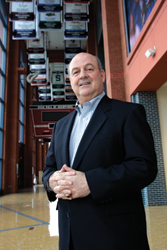 |
MITCHELL REIBEL
Former NCAA exec Jernstedt recalls the days of VCRs, Velcro and six-person committees. |
As the tournament expanded in the 1980s, so did the method by which the committee organized the brackets. Jernstedt laughed as he recalled the great innovation of the 1980s — Velcro.
Rather than writing out all of the brackets by hand in the days before laptops, each team name was attached to Velcro and placed on a line in the bracket, which made it easier to make adjustments. Seemed like a fine idea until they left for dinner one night after completing the brackets, only to find that someone had rearranged all of the team names on the big Velcro board while they were gone.
The selection committee back then saw most of the games on old VHS tapes that were mailed from conference offices. The conferences became so aggressive in sending out tapes and politicking for their teams that Jernstedt had to limit the number that could be sent to committee members from each league.
Now, each selection committee member is assigned as the primary contact for three to four conferences and they stay in touch throughout the season. Whenever a conference sends out a game on DVD, it goes to that conference contact rather than every committee member. That prevents the members from being inundated with video and stats from each of the 31 Division I conferences.
“The amount of data we have access to is enormous,” UConn’s Hathaway said. “Each morning, we log onto our secure site and you see all of these categories of information. You can do direct comparisons of one team against another.”
The sacrifices for living the life of a basketball junkie are significant. ADs accustomed to seeing most or all of the games at their own school miss out. Family time, which is limited anyway, becomes basketball time.
By the time selection committee members convene on the 15th floor of the Indianapolis Westin to make the final picks during conference tournament weekend, they’ve already had mock selections, juggled their seedings and shared their opinions on each at-large candidate several times. This week, they’ll arrive on Tuesday and begin their all-day meetings on Wednesday. Those sessions typically begin at 8 a.m. and last 12 to 13 hours, with a handful of breaks built in. They continuously debate teams through the week, watch conference tournament games and consider seedings right up to Selection Sunday, when the brackets are finalized.
“What I really miss is not being able to go to our conference tournament,” Hathaway said. “Anybody who wants to be a committee member has to understand that something’s got to give and it’s usually whatever free time we ever have, and that’s family time.”
It’s that level of commitment and the overwhelming amount of data that has to be digested by each committee member that concerns Jernstedt, who ran the tournament beginning in 1973 before he left the NCAA last year. There is such pressure and scrutiny on the selection committee to be experts on every team — ESPN updates the “Who’s in, who’s out” graphic with the completion of nearly every game — that they can’t afford an oversight. With all of the additional data to consume and games to watch, the demands on the committee member are like taking on another full-time job from November to March.
“It’s become more and more consuming, and these people have real jobs, very demanding real jobs,” Jernstedt said. “I’m concerned about finding qualified people to serve for this very reason. I know several people who just can’t do it because of the pressures they face in their own jobs.
“And you don’t see the elite coaches moving into administration anymore. The pool of available talent with a basketball background is not what it used to be.”
So the Gene Smiths and the Jeff Hathaways adapt. They call on basketball caretakers like former coach C.M. Newton and former committee members to gauge their opinions. The NCAA also appoints a regional advisory committee of 31 coaches — one coach from each conference — to provide monthly feedback on teams in their region.
It’s just one more piece of information for the committee members to consider when they gather this week to select the top 68 teams.
“There’s a lot of studying to be done,” Smith said. “Rebounding, shooting percentages, fouls, turnovers, efficiency, it’s all available to you. The schedule … it can get kind of crazy.”









